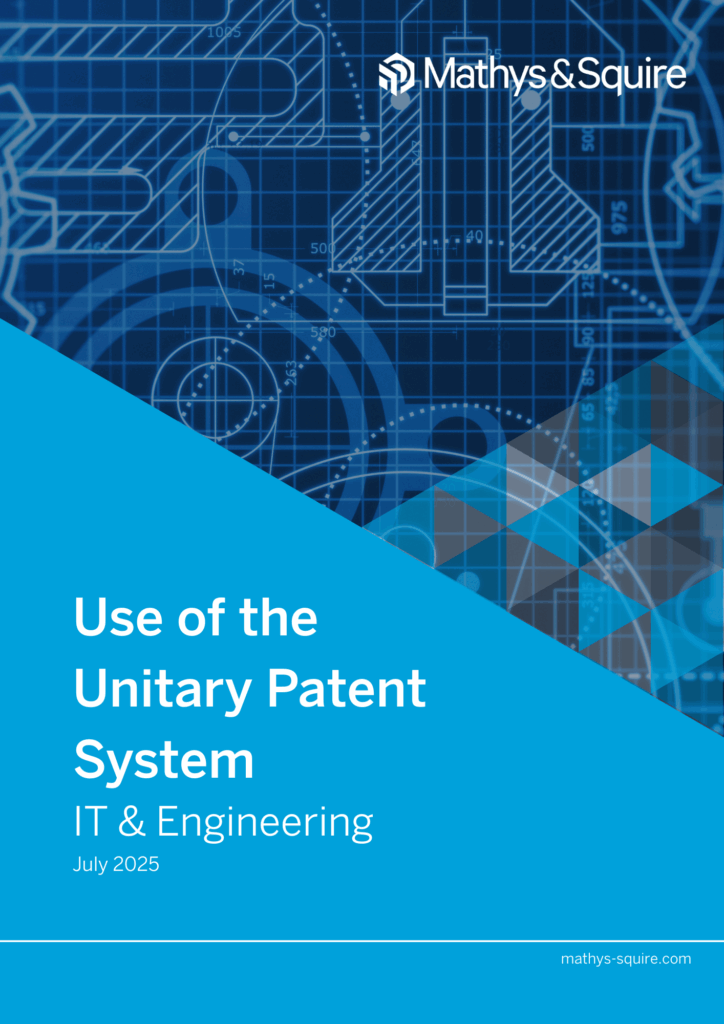Mathys & Squire have published a report on the use of the Unitary Patent system in the field of IT & engineering, sharing the results of a survey on the patents granted to a selected number of applicants in 2023 and 2024 across six technical areas. The report was compiled by Partner Nicholas Fox and Associate Maxwell Haughey.
The Unitary Patent system came into effect on 1 June 2023. Prior to that date, whenever a European Patent was granted, the European Patent automatically became a bundle of national rights for each of the countries designated in the patent. Such national rights need to be maintained separately. In contrast, a Unitary Patent is a unitary right which provides patent protection across all the member states participating in the Unitary Patent system.
Previously, Mathys & Squire sampled a range of applicants in the healthcare sector and investigated their engagement with the Unitary Patent system (view our report here). The analysis revealed that, contrary to popular belief, there was no blanket approach by healthcare companies to engagement with the Unitary Patent system. Rather, widely diverging approaches between different applicants was observed, ranging from almost universal engagement to widespread avoidance.
On the other hand, concerns which may cause diverging approaches to the Unitary Patent system in the healthcare and life sciences field will be different to concerns which applicants in the field of IT & engineering will have.
Applicants in the IT and telecoms field
In contrast to the life sciences where relatively few, but highly valuable, patents are granted, the number of patents in the electronics fields is much larger. Applicants in the IT and telecoms fields consistently appear at the top of the European Patent Office’s list of most frequent filers. However, unlike the life sciences, where patents are normally validated and maintained in a large number of countries, most electronics patents are only ever maintained in the UK, Germany and France. This is more cost effective as due to the London Agreement, applicants do not need to translate their patent into a national language for the patent to have effect in those countries.
For such applicants, engaging with the Unitary Patent system involves a cost, as a full translation of the patent is required. When applicants are obtaining upwards of 1000 granted patents a year, the costs of such translations (typically around €5,000 per patent) will mount up.
Therefore, continuing with the existing approach of only validating patents in the UK, Germany and France, where protection can be obtained without incurring the translation fees, remains attractive.
Applicants in the engineering field
Compared with IT and telecoms, engineering is a half-way house. The volume of patents in the mechanical and engineering sectors is far lower than in the IT and telecoms fields. However, engineering patents are normally maintained more broadly than IT and telecoms patents – typically in around 4-6 jurisdictions (often the UK, Germany and France, and in addition 2-3 other major jurisdictions often selected from Italy, Spain, and the Netherlands). As such, engineering patents very much hit the sweet spot for using the Unitary Patent system. Where patents have traditionally been maintained more broadly, the Unitary Patent system potentially provides the means for patentees to obtain broad geographical coverage at a lower cost than was possible in the past.
In addition, although Unitary Patents are always subject to the jurisdiction of the Unified Patent Court, and as unitary rights they are always subject to the threat of central invalidation, relatively few IT and engineering patents are ever involved in litigation or are the subject of EPO oppositions compared with the life sciences. Opposition rates rarely exceed 3% and for many of these areas of technology opposition rates of less than 1% are common.
Therefore, the Unitary Patent system potentially provides many upsides for engineering applicants with relatively low levels of risk.
Our report on the Unitary Patent system

Whilst the above theorises their approach, the report reveals how applicants in the IT & engineering fields are engaging with the Unitary Patent system in reality. Mathys & Squire’s survey analyses the number of Unitary Patents granted in 2023 and 2024, across six technical areas: digital communication, semiconductors and microchips, civil engineering, transport, defence, and electrical machinery, apparatus and energy. A range of applicants in each area was also sampled to assess the activity of specific applicants.
In summary, the report shows that approaches to the Unitary Patent system vary significantly. However, in general, the percentages of Unitary Patents observed in all IT and engineering fields were lower than the four healthcare fields covered in our previous report, apart from civil engineering, which is perhaps contrary to expectation.
In addition, the percentage of granted IT & engineering Unitary Patents was higher in 2024 than 2023 across all technical fields, which is unsurprising as Unitary Patents were not available for the first five months of 2023. Although applicants had the option of delaying the grant of patents issued in the first half of 2023 until Unitary Patents became available, it seems that relatively few applicants took advantage of this.
Explore the full Use of the Unitary Patent System in IT & Engineering report to uncover changing trends, specific sector insights and the approach of top filers in the industry.

